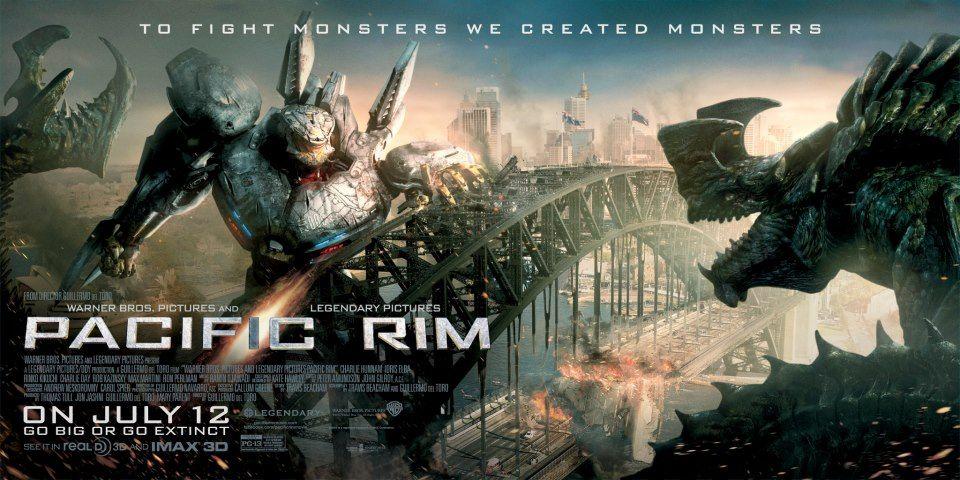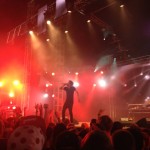There is no better place to begin than the beginning, and so it must be said that Pacific Rim‘s opening twenty minutes offers a salvo of such audacious technical expertise and moviemaking wizardry that it could be argued that it is never quite able to top it.
The film sets up its premise with refreshing speed and expediency, opening with a Ridley Scott-esque info card sequence defining the words kaiju (Japanese for ‘monster’) and jaeger (German for ‘hunter’) – this is all the set-up the audience needs to commit – mech vs monster, science vs nature, good vs evil.
The introduction gives us a brief narration from main character Raleigh Beckett (Charlie Hunnam) describing how colossal, Lovecraftian monsters surfaced from a portal beneath the Pacific Ocean, and how the military forces of the world, eventually exhausted of options given the beasts’ relentlessness, banded together to create the Jaeger program, a defence initiative involving enormous humanoid vehicles designed to combat the creatures face-to-face. The virtuoso opening battle showcases Raleigh and brother Yancy defending the Alaskan coastline from a kaiju dubbed ‘Knifehead’.
The fight doesn’t end well however, and the jaeger program falls into disarray over the next five years, due to the neverending aggression of the kaijus’ attacks and increasing public doubt as to the program’s effectiveness.
Much of the film takes place in a giant Hong-Kong based fortress facility called the Shatterdome, where Idris Elba’s military leader Stacker Pentecost (one of many playfully named characters in the film) leads a last ditch effort to save both the program he helped to create, and in turn, the world, before its governments finish the construction of their backup plan, an enormous wall spanning the Pacific Coast.
Pacific Rim does have some problems with characterisation and dialogue at times; one of the oddly Ocker Australian pilots is an arrogant hotshot who has issues with his father (Max Martini as…err…Hercules Hansen) and doesn’t like Hunnam’s washed-up American flotsam; Japanese pilot Mako Mori (Babel’s Rinko Kikuchi)has a tragic past; Elba’s gruff British sergeant-type is an old hand who is getting a bit long in the tooth for it all, while Charlie Day and Burn Gorman’s wacky scientist characters seem to be competing in a world final for ‘zany’ overacting.
It would be too kind to dismiss such cliches as a product of Pacific Rim’s positive tone, which is delightfully free of cynicism, and children certainly aren’t going to care (despite its 12A certificate, most children over the age of 8 will adore it), but they are flaws nonetheless. It is a testament to Del Toro’s skill as a director, and the talented team behind the film that they never become too grating.
Pacific Rim is something of a blockbuster throwback; it is painfully well-crafted, with every frame bursting with the rich colour palette its director is known for, and the costumes and sets are beautifully and meticulously designed. The pilot suits, helmets and jaegers are all detailed to such a degree that they easily reflect their country of origin and the personalities of the pilots (the Chinese jaeger for example, is a nimble three-armed mecha piloted by triplets, while the Russians favour a hulking mech with a torso reminiscent of a nuclear reactor).
The kaiju are diverse too, and all represent faithful updates of the kind found in the Japanese ‘man-in-suit’ style of Toho monster movie that so inspired this film – one moves like a gorilla, another like a bat, and some are even aquatic.
In a nice change of pace from the eye-battering complexity of Michael Bay‘s Transformers series and its ilk, the action scenes are well-edited and framed with a painterly eye (del Toro cites Hokusai and Goya among his visual inspirations for the battles), so it is always clear who is fighting whom and what is going on – an impressive feat given that most of the punch-ups take place at night amidst heavy rain and crashing waves.
Another minor but pleasing point is the distinct lack of product placement on display; following the deluge of corporate logos in films such as Iron Man 3 and Man of Steel, this represents a pleasing concession to artistic vision.
The visual effects also rank as possibly the most impressive since 2009’s Avatar, and it will be a crime if it doesn’t receive an Oscar nomination in this category. Like Avatar, the 3D is also involving, with del Toro overseeing the conversion process personally, which took upwards of 40 weeks to complete.
It’s been a weak summer for blockbusters overall, so Pacific Rim deserves praise despite some structural flaws. It is a massive budget original IP, a rarity among modern blockbusters – there was no Pacific Rim video game, TV show, comic book, it’s not a reboot or a ‘reimagining’ of some 80s classic. Its ending is self-contained, there is no post-credits teaser or sequel hook in sight.
It is also a clear labour of love for its director, who made this film in lieu of The Hobbit, and with a canvas of heretofore unseen scale to play with, cements himself as one of Hollywood’s great modern visualists, comparable in the same breath to Cameron, Spielberg and Scott.
[Rating:4.5]





